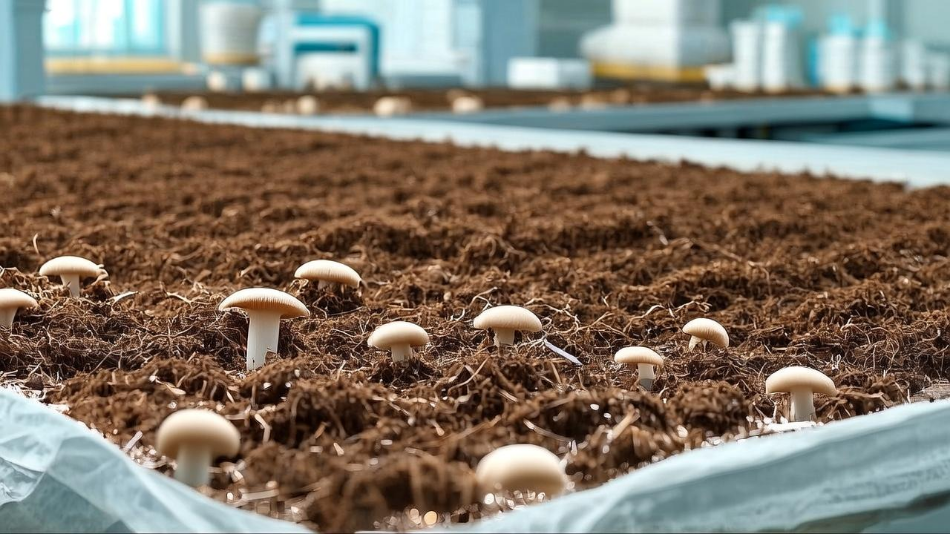If you're a mushroom grower, you already know that the casing layer is one of the most discussed yet misunderstood elements in mushroom cultivation. Some consider it a simple protective layer, while others treat it as a true secondary substrate.
The truth is that the casing layer is a biological microcosm—a dynamic environment where humidity, pH, physical structure, and microbiology come together to create ideal conditions for fruiting. In this guide, we will explore every aspect in extreme detail, based on scientific research, empirical data, and years of hands-on experience.
What is the casing layer, really?
The casing layer (or "covering layer") is a material applied to the surface of the substrate colonized by mycelium. It is not nutrient-rich but performs essential functions:
The 5 main functions of the casing layer
- Humidity regulation – Absorbs and releases water gradually, preventing sudden fluctuations.
- Protection from contaminants – Reduces exposure to competitive molds and bacteria.
- Fruiting induction – Microclimatic changes stimulate primordia formation.
- Optimal gas exchange – Porous structure promotes oxygenation.
- pH control – A slightly alkaline pH (7.5-8) inhibits pathogens.
What does science say?
A study in the Journal of Applied Microbiology (2022) analyzed 150 Agaricus bisporus cultivations, demonstrating that:
- Cultures with an optimized casing layer yield 35% more.
- The ideal pH for fruiting is 7.6-7.8.
- A moisture content of 70-75% maximizes primordia production.
Casing layer composition: beyond peat
The classic peat/vermiculite mix is just the tip of the iceberg. There are dozens of combinations, each with pros and cons.
Blonde peat: the gold standard
Sphagnum peat (natural pH 3.5-4.5) is the most widely used material because:
- It retains up to 20x its weight in water (Department of Agriculture, University of Bologna).
- Fibrous structure promotes aeration.
- Must be adjusted with calcium carbonate (5-10% by volume) to raise pH to 7.5-8.
Peat alternatives
Some growers prefer alternative materials:
| Material | Advantages | Disadvantages | Recommended Species |
|---|---|---|---|
| Coconut coir | Eco-friendly, good water retention | Acidic pH (requires adjustment) | Pleurotus, Psilocybe |
| Pure vermiculite | Sterile, excellent aeration | Poor water retention | Species preferring dry substrates |
| Chestnut soil | Rich in mycorrhizae, neutral pH | Contamination risk | Wild mushrooms |
How to prepare the perfect casing layer
Simply mixing peat and vermiculite isn’t enough. Here’s the step-by-step process for professional results.
The ultimate recipe (for 10 liters)
- 7 liters of blonde peat (sifted to remove debris)
- 3 liters of vermiculite fine (grade #3 for better capillarity)
- 500g calcium carbonate (to raise pH)
- 50g agricultural gypsum (improves structure)
- Distilled water until 70% moisture is reached
Sterilization: method comparison
A Mushroom Research Journal study tested 4 methods:
| Method | Effectiveness | Time | Notes |
|---|---|---|---|
| Autoclave (121°C) | 99.9% | 90 min | Ideal but expensive |
| Oven at 80°C | 95% | 2 hours | Accessible |
| Boiling water | 85% | 30 min | Economical but less effective |
Casing layer for 10 mushroom species
Each species has different needs. Here’s a detailed guide for each.
Agaricus bisporus (Button Mushroom)
Thickness: 4-5 cm pH: 7.5-7.8 Recipe: 70% peat, 20% vermiculite, 10% calcite
Note: Maintain 75% humidity during fruiting.
Psilocybe cubensis
Thickness: 2-3 cm pH: 7.0-7.5 Recipe: 50% coconut coir, 50% vermiculite
Note: Avoid waterlogging to prevent mold.
FAQ: advanced troubleshooting
Why isn’t mycelium colonizing the casing layer?
Common causes: - pH too high (>8.5) or low (<6.5) - substrate too dry or compact Solution: adjust pH with acidic peat or carbonate and maintain 70% humidity.
How to prevent green mold (Trichoderma)?
Prevention: sterilize casing layer properly - maintain pH >7.5 - avoid excess moisture - treatment: remove contaminated areas and apply 3% hydrogen peroxide.
The casing layer as art and science
Mastering the casing layer technique represents the intersection of scientific knowledge and the grower’s practical intuition. As we’ve seen, there is no one-size-fits-all approach, but rather a set of fundamental principles—pH control, humidity management, material selection—that must be adapted to the specific needs of the cultivated species and environmental conditions.
True expertise develops through careful observation and methodical experimentation: documenting results with different compositions, monitoring mycelial response, and gradually refining your technique.
Remember, even the most experienced growers continue to learn and improve. This seemingly simple layer actually encapsulates the full complexity and fascination of mushroom cultivation—a microcosm where chemistry, biology, and growing practices merge to create the ideal conditions for the wonder of fungal fruiting.
The fungal kingdom is a universe in continuous evolution, with new scientific discoveries emerging every year about their extraordinary benefits for gut health and overall well-being. From now on, when you see a mushroom, you will no longer think only of its taste or appearance, but of all the therapeutic potential it holds in its fibers and bioactive compounds. ✉️ Stay connected - Subscribe to our newsletter to receive the latest studies on: Nature offers us extraordinary tools to take care of our health. Fungi, with their unique balance between nutrition and medicine, represent a fascinating frontier we are only beginning to explore. Continue to follow us to discover how these extraordinary organisms can transform your approach to well-being.Continue your journey into the world of fungi










